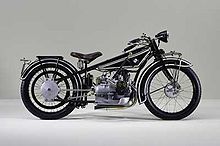Max Friz
Max Friz | |
|---|---|
| Born | October 1, 1883 BMW AG |
| Known for | Critical contributions to the founding of BMW AG |
| Title | Chief Designer/ Chief Engineer |
| Term | 1916–1945 |
Max Friz (October 1, 1883 – June 9, 1966)[
Early life
Assumed to be originally from
Friz designed the first practical German aircraft engines in 1912-1913 while at
At the Daimler engine company, Max Friz had tried in vain to develop an oversized, high-compression engine, but Paul Daimler had firmly committed himself to supercharger technology. Not until he had moved to Munich was Friz able to put his own ideas for a high-altitude engine into practice. In the space of a few weeks he designed a new aero-engine, which, with an innovative carburettor and a variety of other technical details, was superior to any other German aero-engine. Later, this engine would gain world renown under the designation "BMW IIIa".
Aircraft engines

Upon arriving at Rapp Motorenwerke, Friz was tasked to develop an aircraft engine that could attain very high altitudes as well as be durable and aerodynamically favorable. A higher operational flight ceiling was a critical strategic advantage for the pilot (since the atmospheric pressure decreases the higher a pilot flies a plane, a conventional engine at this time literally stalled out above 3,000 meters).
In the spring of 1917, at the time Friz was working at the drawing board on his groundbreaking engine, the outlook for Rapp Motorenwerke was bad. The Army High Command wanted to commit itself to a few types of aircraft and aeroengine and then get these built under license by several companies. In the spring of 1917 a commission from the Reichswehr therefore inspected the Rapp engine plant. They had to decide which engines would in future have to be produced under license in Munich. In the end, the Rapp management was faced with the choice of manufacturing either Daimler or Benz engines. However, Franz Josef Popp seized the opportunity of presenting the new engine to the commission of experts, an engine which up to now had only existed in Max Friz's drawings.
The interest shown by the officers was considerable, and soon there was no more talk of the Rapp engine factory being relegated to the rank of a mere assembler. In fact, the Reichswehr was so impressed by the new engine that it placed an order for 600 units, even before a single prototype had been produced. The aeroengine developed by Friz had turned Rapp Motorenwerke into an essential contributor to the war effort virtually overnight.
On 20 May 1917, Rapp Motorenwerke registered the documentation for the construction design for the new engine, dubbed project "BBE". Friz' design, based on Karl Rapp's design) was laid out as an in-line six-cylinder, which guaranteed optimum balance, therefore few, small vibrations. The engine was successful, but the real breakthrough came in 1917, when Friz integrated a basically simple
It was the success of this engine that allowed the company to grow exceptionally fast, necessitating the restructuring of the company. In 1917, Rapp Motorenwerke is renamed
Motorcycles
With World War I over, the company was forbidden from aircraft design. This necessitated the need for new avenues of growth for the company. Friz, with his designs and engineering expertise, launches BMW into the motorcycle market with the development of the R32 motorcycle, which established the foundation for all future boxer powered BMW motorcycles (in addition to numerous motorsport titles and world records).

Friz and his team of engineers design the first "boxer" (or

With the development of its first light alloy
The engine and
Automobiles
Friz was appointed to General Manager of BMW-Flugmotorenbau GmbH, Munich in 1934, and was there until 1937. With BMW continued growth into automobiles, Friz succeeded Leo C. Grass as General Manager of Flugmotorenfabrik Eisenach GmbH, overseeing development of automobile engine design and development. Friz retired from BMW in 1945. He was honored with an Honorary Doctorate from the Munich College of Advanced Technology in 1954.
Friz died in Tegernsee on June 9, 1966.[citation needed]
See also
References
- ^ BMW Group archives
- ^ BM Bikes BMW R32 specifications
